Is there a pomegranate without seeds and how to distinguish it from the usual
The seedless pomegranate is a product of the selection work of American breeders. It appeared relatively recently, but has already spread in countries with a warm climate. Juicy, sweet, slightly watery grains still contain small soft bones, but eating the fruit has become much easier.
In this article, we will talk about the varieties, beneficial properties, external signs of pomegranate without seeds, by which you can distinguish this variety from ordinary pomegranate.
The content of the article
Is there a pomegranate without seeds
Garnet seedless really exists, and it appeared relatively recently thanks to the work of American specialists... Since the bones are necessary for the propagation of the culture, you cannot completely get rid of them. However, they are smaller in size, much softer and hardly noticeable when consumed.
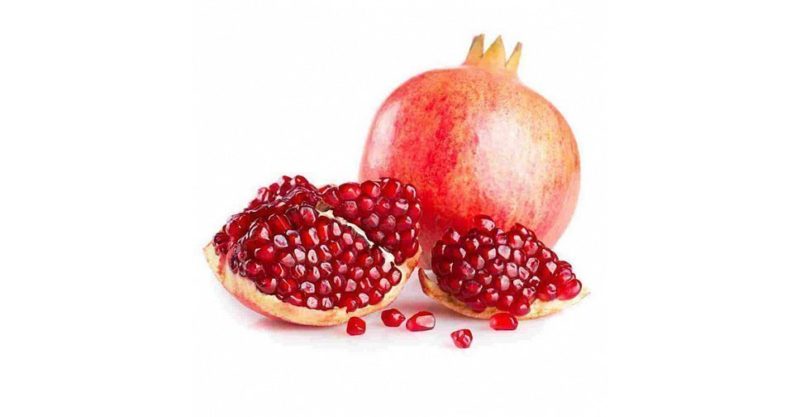
How to tell a seedless pomegranate from a regular pomegranate
To distinguish the seedless pomegranate from the regular fruit, pay attention to its appearance. The peel is thinner and squeezes easily when pressed with a fingernail. The color varies from yellow with a slight blush to scarlet, depending on the varietal characteristics.
The fruit weighs less due to the lack of seeds. These grenades appear on sale in September-October.
What it looks like and where it grows
The appearance of pomegranate pomegranate tree and common pomegranate tree is no different. This is a low-growing shrub or tree 5-6 m high. The growing season is 6-8 months. The first crop is harvested 3 years after planting.
The branches are thin with thorns. Leaves are oval, smooth, with a slight shine, 3 cm long. The color is green.
The flowers have a diameter of 2.5-4 cm. The shape is funnel-shaped. Coloring orange-red. The petals contain punicin, a natural dye.
Types of flowers:
- bisexual, in the form of a jug, fruit ovaries appear from them;
- bell-shaped - do not bear fruit.
The triangular cup has dense lobes. In her throat, stamens and petals arise.
The fruits are in the shape of a ball. At the end there is a leathery pericarp and calyx. The skin is thin, yellow or scarlet. Diameter - 15-18 cm. Fruits do not tolerate transportation due to their thin rind.
Boneless pomegranates are actively cultivated in the USA, Spain, Turkey, Transcaucasia, China. The most suitable climate for culture is in Spain. It is in this country of pomegranates grow in large quantities, sufficient for domestic consumption and export.
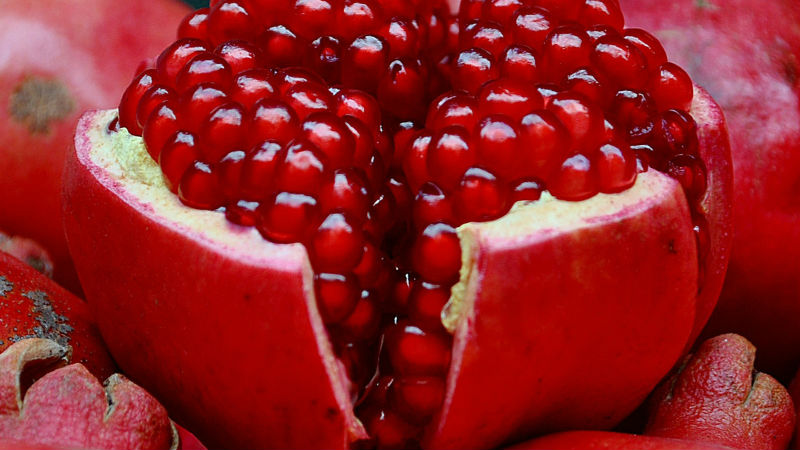
Varieties
There are currently two varieties of seedless pomegranate in the world:
- Wonderful - a variety of American selection. Differs in light yellow skin color. The weight of one fruit is 250-300 g.
- Mollar de elche - a product of the selection work of the Spaniards. The skin is thin, scarlet in color. Fruit weight - 400-600 g.
The seeds of both varieties of pomegranate are soft, almost imperceptible. The grains are juicy, sweet, watery in taste. They contain less acid than pitted grains.
Interesting. According to ancient Greek mythology, the seasons change due to the pomegranate. After the abduction of the kingdom of the dead by Hades, the daughter of the goddess of fertility Proserpina ate six pomegranate seeds in honor of the marriage. Obeying the terms of the marriage agreement, she lived for six months in the kingdom of the dead, and a cold winter came on earth.
The chemical composition and use of pomegranate
The vitamin and mineral composition of pitted grains is no different from the composition of pomegranate with seeds.
The table shows the content of vitamins and minerals per 100 g of the product.
| Name | Content | Norm |
| Vitamin A | 5 μg | 900 mcg |
| beta carotene | 0.03 mg | 5 mg |
| Vitamin B1 | 0.04 mg | 1.5 mg |
| Vitamin B2 | 0.01 mg | 1.8 mg |
| Vitamin B4 | 7.6 mg | 500 mg |
| Vitamin B5 | 0.54 mg | 5 mg |
| Vitamin B6 | 0.5 mg | 2 mg |
| Vitamin B9 | 18 mcg | 400 mcg |
| Vitamin C | 4 mg | 90 mg |
| Vitamin E | 0,4 mg | 15 mg |
| Vitamin H | 0.4 μg | 50 mcg |
| Vitamin K | 16.4 μg | 120 mcg |
| Vitamin PP | 0.5 mg | 20 mg |
| Niacin | 0,4 mg | — |
| Potassium | 150 mg | 2500 mg |
| Calcium | 10 mg | 1000 mg |
| Silicon | 5 mg | 30 mg |
| Magnesium | 2 mg | 400 mg |
| Sodium | 2 mg | 1300 mg |
| Sulfur | 16,7 mg | 1000 mg |
| Phosphorus | 8 mg | 800 mg |
| Chlorine | 2 mg | 2300 mg |
| Aluminum | 110 mcg | — |
| Boron | 54.4 μg | — |
| Vanadium | 14 μg | — |
| Iron | 1 mg | 18 mg |
| Iodine | 2 μg | 150 mcg |
| Cobalt | 2.1 μg | 10 mcg |
| Lithium | 0.9 μg | — |
| Manganese | 0.119 mg | 2 mg |
| Copper | 158 mcg | 1000 mcg |
| Molybdenum | 5.1 mcg | 70 mcg |
| Nickel | 1.8 μg | — |
| Rubidium | 37.6 mcg | — |
| Selenium | 0.5 μg | 55 mcg |
| Strontium | 19.4 μg | — |
| Fluorine | 58.7 mcg | 4000 mcg |
| Chromium | 1.5 mcg | 50 mcg |
| Zinc | 0.35 mg | 12 mg |
| Zirconium | 6.1 μg | — |
KBZHU
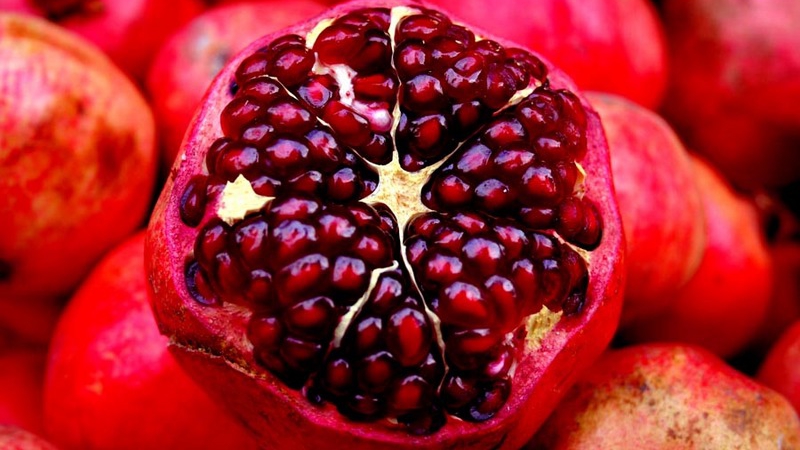
Nutritional value of the product per 100 g:
- calorie content - 50 kcal;
- proteins - 0.7 g;
- fats - 0.6 g;
- carbohydrates - 14.5 g;
- fiber - 0.9 g
Benefits for the body
Pomegranate supports the work of the heart thanks to the content of the substance punicalagin, which neutralizes free radicals. Antioxidants in grains strengthen blood vessels, increase the elasticity of their walls, break down and remove cholesterol plaques. Just 30 ml of pomegranate juice per day reduces the risk of plaque on the walls of blood vessels by 30%.
Pomegranate seeds contain 21% of the daily value of vitamin K. It takes part in the construction and metabolism of connective and bone tissues, helps to absorb calcium. Regular use of the product prevents cartilage deformation in osteoarthritis. Phytonutrients reduce inflammation and tissue swelling.
Other beneficial properties:
- Pomegranate juice removes plaque kills germs and viruses in the oral cavity, reduces the risk of periodontal disease.
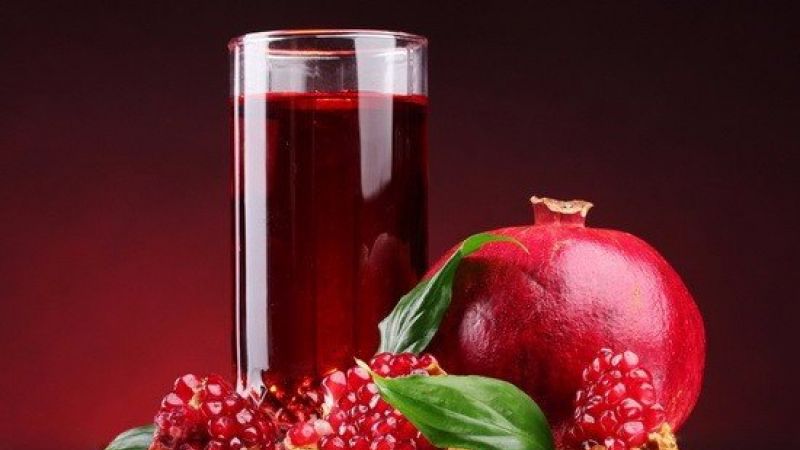
- Ellagitannins are substances that inhibit the production of estrogen and the growth of cancer cells. American scientists have proven that regular consumption of pomegranate prevents the development of breast cancer.
- Pomegranate extract contains substances that reduce inflammation and oxidative processes in the body. Against the background of regular consumption of pomegranate seeds in men, the risk of prostate and lung cancer is reduced, especially against the background of smoking abuse.
- Pomegranate activates the body's defenses, helps fight viruses and bacteria in the season of colds and flu... Eating ¼ pomegranate is enough to strengthen the immune system.
- Fiber normalizes digestive function, the intestines work like a clock, lightness appears, and well-being is significantly improved. Pomegranate juice improves appetite and quickly quenches thirst.
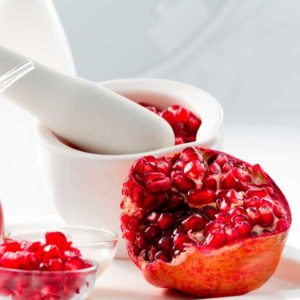 Pomegranate seeds contain oil that promotes cell regeneration and accelerates the healing of skin lesions and sunburn, stimulates the production of elastin and collagen.
Pomegranate seeds contain oil that promotes cell regeneration and accelerates the healing of skin lesions and sunburn, stimulates the production of elastin and collagen.- Natural pomegranate juice is prescribed for children and adults with low hemoglobin levels and iron deficiency anemia. Against the background of a decrease in the number of red blood cells, the body experiences an acute shortage of oxygen, which primarily affects the condition of the nails and hair. Regular consumption of pomegranate strengthens the hair follicles and prevents hair loss.
- A moderate amount of pomegranate seeds is permissible to use for diabetes. The juice has a diuretic effect, reduces swelling, which is characteristic of this disease.
- Research published in 2006 suggests that pomegranate prevents the development of Alzheimer's disease. This is due to its high antioxidant content. They reduce inflammation in the brain and inhibit age-related dementia.
- Pomegranate extract is used in traditional medicine as an anti-aging supplement that slows down skin aging. Against the background of regular intake of pomegranate, the elasticity of the skin of the face increases, the network of fine wrinkles decreases, age spots become lighter, and new ones do not appear.
Who benefits from this pomegranate
Seedless pomegranates are especially useful for children and people with digestive disorders. Since there are no hard bones inside, the gastrointestinal tract is easier and faster to cope with soft, small seeds.
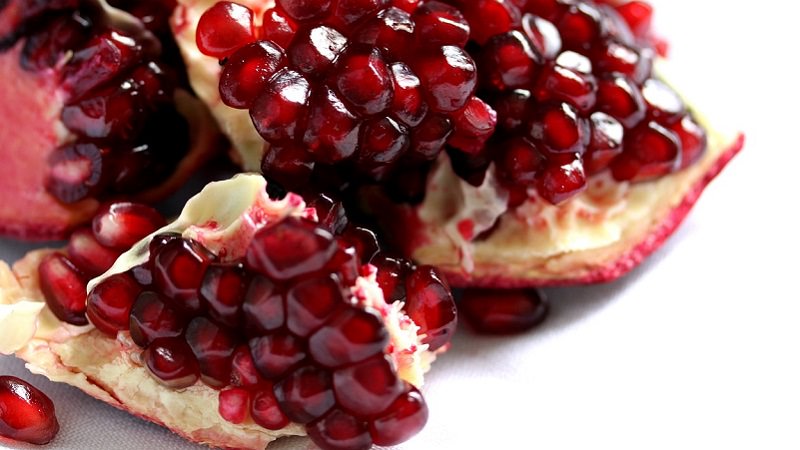
Harm and contraindications
Pomegranate is contraindicated for:
- gastritis with high acidity;
- stomach ulcer and 12 duodenal ulcer;
- under 1 year of age due to the risk of allergic reactions;
- hemorrhoids;
- chronic constipation;
- acute pancreatitis;
- allergies to the product.
When consumed excessively, pomegranate can cause stomach and intestinal upsets of varying severity.
It is interesting:
Step-by-step guide to propagating pomegranate cuttings at home.
Conclusion
American breeders have tried their best and brought out the perfect pomegranate for those who do not like the seeds inside the seeds. Still it was not possible to completely get rid of them, however, they became soft and almost invisible when used. The chemical composition is the same as that of a product with seeds, except that the calorie content is lower. For comparison, 100 g of pitted grains contains 72 kcal, without - 50 kcal.
Pomegranate is useful for children and adults, supports the digestive tract, immune, cardiovascular, circulatory systems. Regular use reduces the risk of developing cancer and senile dementia.